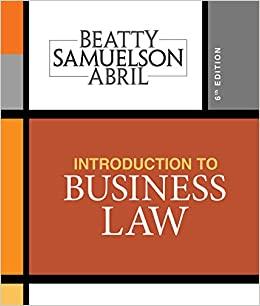Question
MULTIPLE CHOICE 1) The cost-benefit principle indicates that an action should be considered: A. if the costs are low. B. if the benefit is high.
MULTIPLE CHOICE 1) The cost-benefit principle indicates that an action should be considered: A. if the costs are low. B. if the benefit is high. C. If the NPV of the Do Nothing alternative = 0. D. None of the above.
2) The best rule for a good social CBA is a) PV(C) = S [B/(1+i)] b) NPV = PV(B) - (C) c) NPV = PV(NSB) d) NetBenefits = B-C e) B/C>1
3) Which of the following does not belong? a) A lot of CBA benefits are hard to quantify. b) A lot of CBA outcomes are not clear. c) Everyone agrees CBAs are appropriate analytical tools. d) None of the above.
4) Curly used his frequent flyer miles to fly to visit Moe. Curly told Moe that it didn't cost him anything to visit. Is Curly correct? a) Yes, because Curly's frequent flyer miles made the trip free. b) Yes, because Curly could stay at Moe's house for free. c) No, because Curly could have used his frequent flyer miles to go somewhere else, but chose to visit Moe. d) No, because Curly had to pay for earlier trips in order to earn the frequent flyer miles.
5) If a focus on jobs is chosen as the most meaningful measure of success for a CBA, it
a) Condemns the analysis to failure. b) Necessarily skews the results. c) Will not be useful. d) None of the above.
6) Cost-beneifit analysis attempts to:
a) compare the real worth, rather than the market values, of various goods and services. b) compare the relative desirability of alternative distributions of income. c) determine whether it is better to cut government expenditures or reduce taxes. d) compare the benefits and costs associated with any economic project or activity.
7) Taken from a health care exam: Which of these statements about a CBA does not belong with the others?
a) Health CBAs are easily identified because they consider costs. b) A health CBA is the only type of analysis that provides information on efficiency. c) A health CBA requires the identification, measurement and valuation of both a project's costs and consequences (effectiveness; benefits). d) Health CBAs compare BOTH the costs and consequences (effectiveness; benefits) of TWO or more alternatives
8) Cost-effectiveness analysis (CEA) differs from cost-benefit analysis (CBA) in that
a) CBA does not attempt to evaluate efficiency whereas CEA does. b) CBA monetizes both costs and benefits, whereas CEA frequently only monetizes costs. c) CBA assumes geometric discounting whereas CEA does not. d) None of the above.
9) The cost-benefit principle indicates that an action should be considered if:
A. if the total benefits exceed the total costs. B. if the average benefits exceed the average costs. C. if the net benefit (benefit minus cost) is zero. D. if the marginal benefit is greater than the marginal costs.
10) Chris was accepted at three different graduate schools and must choose just one. Elite U costs $50,000 per year and did not offer Chris any financial aid. Chris values attending Elite U at $60,000 per year. State College costs $30,000 per year and offered Chris an annual $10,000 scholarship. Chris values attending State College at $40,000 per year. NoName U costs $20,000 per year and offered Chris a full $20,000 annual scholarship. Chris values attending NoName at $15,000 per year. Chris' opportunity cost of attending Elite U is:
a) $ 5,000
b) $10,000
c) $15,000
d) $20,000
Step by Step Solution
There are 3 Steps involved in it
Step: 1

Get Instant Access to Expert-Tailored Solutions
See step-by-step solutions with expert insights and AI powered tools for academic success
Step: 2

Step: 3

Ace Your Homework with AI
Get the answers you need in no time with our AI-driven, step-by-step assistance
Get Started


